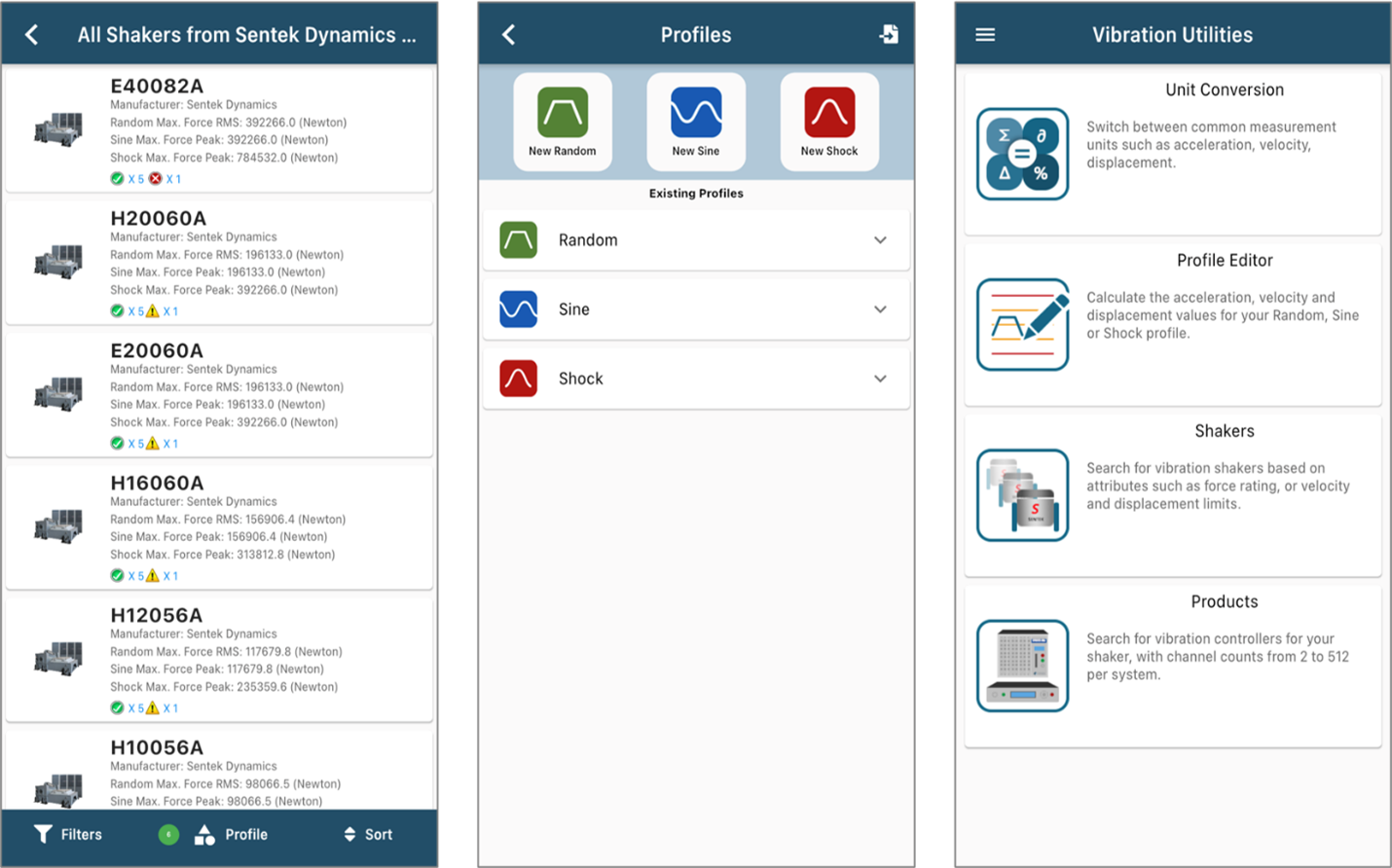Multi-Sine Vibration Testing
Single Axis Shaker Vibration Testing
Multi-Sine vibration testing can simultaneously sweep multiple sine tones, helping reduce test time and excite multiple resonant frequencies at once. Independent tracking filters are applied to each tone separately. Includes support for notching and limiting.
Number of Sine Tones: up to 10 tones
Configuring Sine Tone Frequencies: evenly split across spectrum, manually defined, or set as harmonics
Operation Controls: Tone On and Tone Off controlled by run schedule or manual command
Number of Inputs: supports up to 512 input channels
Multi-Sine Vibration Test
Control Parameters
- Frequency Range: up to 46 kHz
- Sweeping Speed: Log (Oct/Min): 0.01 to 6000; Log (Dec/ Min): 0.001 to 2000; Linear (Hz/Sec): 0.001 to 6000
- Spectrum Display Resolution: 256 to 4,096
- Control Dynamic Range: 90 dB typical
- Tracking Filters: Proportional bandwidth: 7%, 12%, 25%, 50%, 100%; Fixed bandwidth (Hz): is automatically calculated
- Control Accuracy: ±1 dB at 99% confidence with 100 average number
- Frequency Resolution: as fine as 0.0001 Hz
- Average Number: 1 – 2000
Run Schedule
- Run Schedule: a schedule includes an unlimited number of test entries and user-defined events
- Multi-Sine Sweep Entry: fixed range and speed for multiple tones
- Multi-Sine Dwell Entry: set dwell time duration and level for multiple tones
Unique Features in Multi-Sine Vibration Testing
Vibration Visualization: The EDM Vibration Visualization feature is available in EDM VCS software all test types, including MIMO VCS. This option provides fast and efficient structural model generation and full 3D visualization of the online vibration pattern on the structure under test.
Multiple instances of EDM VCS can run simultaneously on the same computer. Each instance connects a Spider system to run the vibration controller software. All instances must run different tests. This feature provides a central place to control multiple Spider systems and perform vibration tests separately.
Black Box Mode: Operating Without a PC
A supported front-end can operate in Black Box mode which allows it to perform a test without a connected PC. In this mode, a PC is used only to configure the system before the test and then to download the data after the test is complete.
Multi-shaker control (MSC) is a unique feature offered enables users to view and monitor multiple shaker tests from one PC station. Up to 12 controllers can be accessed simultaneously.
Limiting - Limiting is applied to control or monitor channels. Abort limit is the only available type. Limiting profiles may be edited by the amplitudes and frequencies of breakpoints. The max expected peak acceleration, velocity and displacement of profile is calculated. Supports up to 512 input channels.
Continuous Data Recording
During vibration testing, all measurement input and drive signals can continuously record to a Spider-NAS or the internal storage residing in each front-end. Users can view and analyze data files with Crystal Instruments Post Analyzer. The variable sampling rate can be enabled to simultaneously record slow-change signals together with high speed vibration data.
Vibration Utilities App
Crystal Instruments in partnership with our sister shaker company Sentek Dynamics provides users with the Vibration Utilities mobile app on iOS and Android. This app provides calculation features for sizing your vibration profile (Random, Sine or Shock) and searches through our catalogue of shakers and controllers for the best fit.



Notching and Limiting
Limiting is applied to control or monitor channels. Three types of limiting are available in Sine Control: frequency domain, time domain, and advanced limit. Two types of limiting are available in Multi-sine control: frequency domain and time domain.
Frequency domain limiting is spectrum limiting. Limit types are notching limit, abort limit, and alarm limit. Time domain limiting compares raw data or the RMS value of input channels to the high limit. The occurrence of exceeding the high limit is one of the system events to which desirable actions can be added. Advanced limit includes summed channel notching and vector notching.
A summed virtual channel is defined as the weighted average of raw time stream signals from multiple input channels. The Notch profile of a summed channel is defined in the frequency domain.
A vector RRS signal is defined as the vector sum of raw time stream signals from three input channels. The notch profile of a vector RRS signal is defined in the frequency domain as well.
Supports up to 128 notching/limiting channels out of 512 input channels.
Spider Vibration Testing Hardware
A Spider system can consist of one or more Spider vibration test controllers. The user constructs the system by combining Spider vibration testing hardware detected on the same LAN. The software validates and displays hardware attributes of each Spider vibration test controller. The following hardware is supported by EDM VCS software for vibration testing, monitoring, and data acquisition.
- Spider-81/81B Vibration Test Controller
- Spider-80Xi High Channel Vibration Test Controller - Scale up to 512 Channels
- Spider-80X Dynamic Measurement & Vibration Control System
- Spider-80M MIMO Vibration Test Controller
- Spider-80SG General Data Acquisition Device with Strain Measurement
Related Vibration Testing Software Options
- Swept Sine Vibration Testing
- Resonance Search and Tracked Dwell (RSTD) Control
- Total Harmonic Distortion (THD) Measurement for Sine for Vibration Testing
- Sine Oscillator in Random Vibration Testing
Monitoring Through EDM Cloud
All tests in EDM-VCS support status checks through EDM Cloud. With EDM Cloud support, users can set up any VCS test to upload live data or run logs for completed tests to a cloud storage space provided by Crystal Instruments, where data is securely stored in the user’s account.
The EDM Cloud website is located at https://cloud.go-ci.com. Users can access EDM Cloud from anywhere in the world to check the status of past and current tests. A secure login flow ensures the status can only be checked by authorized personnel with proper credentials. Multiple logins for accessing the same Cloud account is available.
|
|
|
|
|
|
|
|

